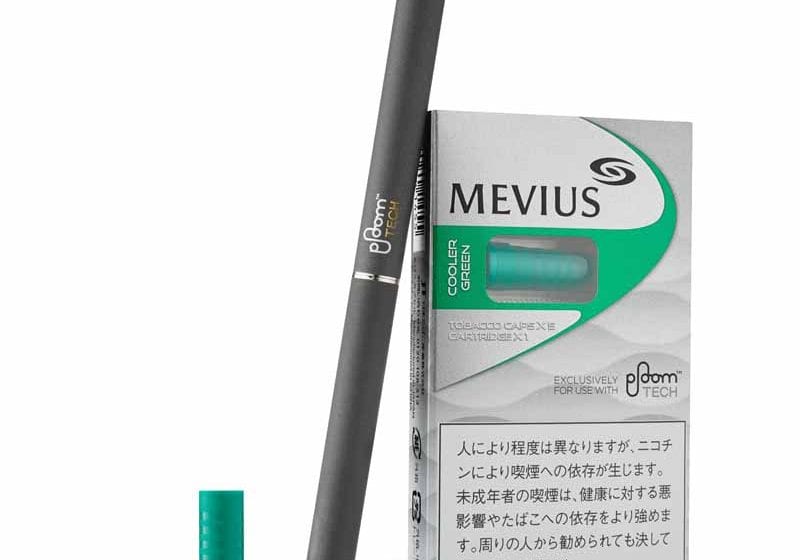JTI volumes down in 2017

According to JTI, Ploom Tech combines the best attributes of e-cigarettes and traditional tobacco.
Japan Tobacco Inc. reported today that its domestic cigarette sales volume during the year to the end of December, at 92.9 billion, was down by 12.5 percent on that of the year to the end of December 2016, 106.2 billion.
JT said that the fall in volume had been due mainly to the contraction in industry-wide volumes caused by the expansion of the reduced-risk products category, and the continuing long-term market decline.
The industry-wide volume during the year to the end of December was given as 151.4 billion, down 12.9 percent from the volume recorded during 2016, 173.8 billion.
JT’s cigarette market share increased by 0.3 of a percentage point to 61.3 percent, year to year.
JT’s revenue during the year to the end of December, at ¥626.8 billion, was down 8.4 percent on that of the year to the end of December 2016, ¥684.3 billion, while core revenue fell by 9.1 percent to ¥590.6 billion as the cigarette sales volume decline offset the benefit of a Mevius-brand retail price rise last year, and increased sales of Ploom TECH, which rose above ¥10 billion. Core revenue excludes the revenue from distribution of imported tobacco on the domestic market, revenue from domestic duty-free sales, revenue from JT’s China business, and revenue from the sale of reduced-risk products such as Ploom TECH devices and capsules.
Adjusted operating profit during the year to the end of December fell by 10.7 percent to ¥232.3 billion, from ¥260.2 billion during the year to the end of December 2016. The fall in adjusted operating profit came about because of the lower core revenue and despite cost decreases having been made.
Meanwhile, Japan Tobacco International’s total tobacco (including cigarettes, fine-cut, cigars, pipe tobacco and snus, but excluding water-pipe tobacco, reduced risk products and contract manufactured goods) shipment volume during the year to the end of December, at 398.5 billion, was down by 0.1 percent on that of the year to the end of December 2015, 398.7 billion.
But JTI’s global flagship brand shipment volume was increased by 0.8 percent from 283.7 billion to 285.9 billion.
JT reported that JTI’s shipment was stable as industry volume contraction was almost offset by volume increases primarily in Iran and emerging markets, market share gains and acquisitions in Indonesia and the Philippines. Excluding acquisitions, JTI’s volume declined 2.1 percent.
JTI’s revenue during the year to the end of December, at ¥1,237.6 billion, was increased by 3.2 percent on that of the year to the end of December 2016, ¥1,199.2 billion, while core revenue rose by 3.4 percent to ¥1,177.0 billion.
Adjusted operating profit was up by 4.5 percent to ¥351.3 billion.
JT’s consolidated revenue for the year to the end of December, at ¥2,139.7 billion, was down by 0.2 percent on that of the year to the end of December 2016, ¥2,143.3.
Operating profit was down by 5.4 percent to ¥561.1 billion, while adjusted operating profit was down by 0.3 percent to ¥585.3 billion.
Masamichi Terabatake, president and CEO of the JT group said that the 2017 results demonstrated the group’s ability to deliver solid profit in an ever-challenging business environment.
“In my first year as CEO, I will focus on ensuring success in the domestic tobacco business, an essential driver for our future growth,” he said. “We will also continue to actively invest in both traditional tobacco and reduced-risk products with the ambition to hold the No.1 market share position in reduced-risk products in Japan by the end of 2020.
“I believe our management principle is well suited to achieve this sustainable profit growth in the mid- to long-term. We need to enhance our organization’s ability to face the competition by being faster and bolder across all our operations.
“We are confident that we can deliver mid to high single-digit annual average growth rate in adjusted operating profit at constant FX in the mid to long-term with our planned investments. Moreover, we are committed to growing the dividend per share year-on-year in line with mid-term profit guidance.”